1. Reading about Hemophilia: A Sex Linked Trait
Earlier in AP Bio Unit 5, we discussed sex determination. As you learned, in humans and all other mammals, sex is determined by sex chromosomes. These chromosomes are also known as the X and Y chromosomes, and the way they determine sex is as follows:
- If you possess an X chromosome and a Y chromosome, you’re male.
- If you possess two X chromosomes, you’re female.
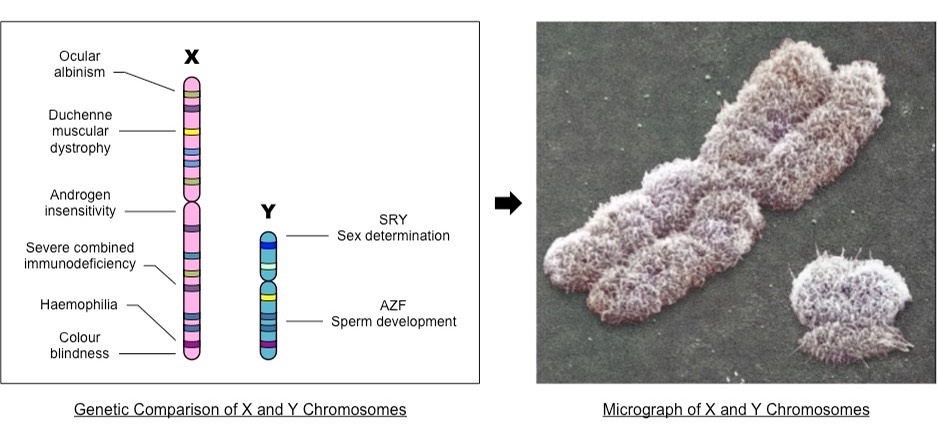 As you can see in the photograph on the left, the X-chromosome is bigger than the Y-chromosome. The X chromosome has about 155 million base pairs and between 900 and 1400 genes; the Y has about 60 million base pairs and between 70 and 200 genes. As a result, as shown in the accompanying partial chromosome map, most of the genes on the X chromosome have no corresponding allele on the Y chromosome.
As you can see in the photograph on the left, the X-chromosome is bigger than the Y-chromosome. The X chromosome has about 155 million base pairs and between 900 and 1400 genes; the Y has about 60 million base pairs and between 70 and 200 genes. As a result, as shown in the accompanying partial chromosome map, most of the genes on the X chromosome have no corresponding allele on the Y chromosome.
This makes the inheritance of genes on the X chromosome different from genes that are on autosomal (non-sex) chromosomes. And to see how, let’s look at a gene that’s close to the bottom of the X chromosome: the gene for hemophilia.

Hemophilia is a recessive inherited blood disorder. Hemophiliacs can’t form blood clots.
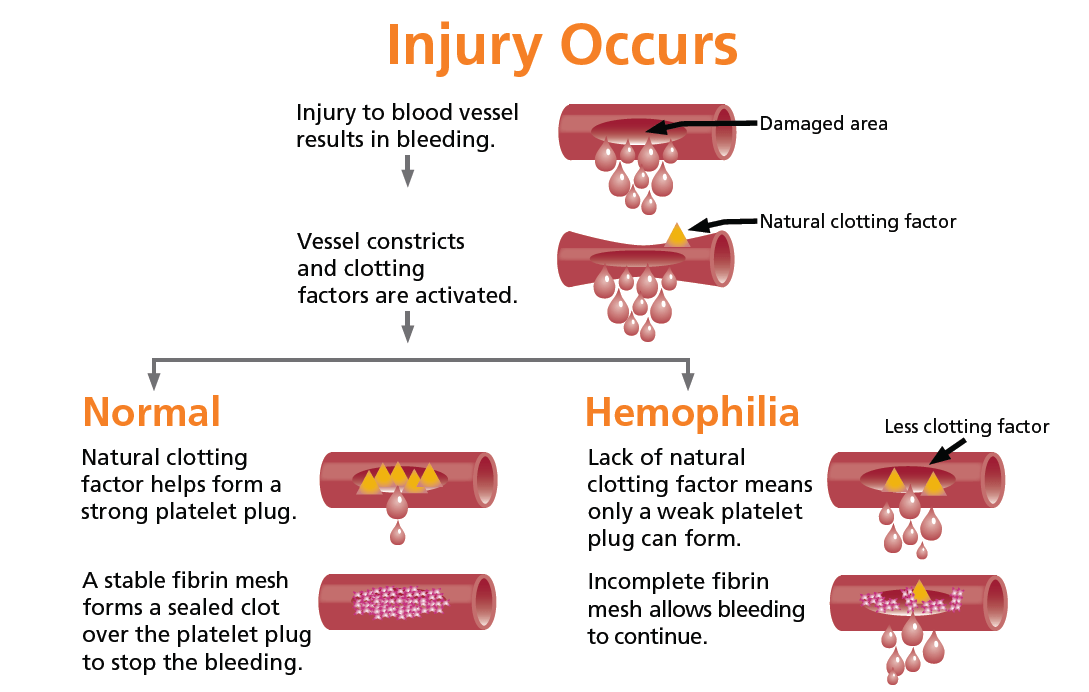
This inability stems from an inherited mutation that results in a defective clotting factor protein. In people with a normal version of the protein, clotting factors interact with cell fragments called platelets to create a blood clot that stops bleeding. In hemophiliacs, a lack of a clotting factor prevents a clot from forming, allowing bleeding to continue.
How is this disease inherited? If you’re a male hemophiliac, you’ve inherited the recessive allele that causes the disease through your X chromosome.
Males only have one X chromosome. So, if a male inherits an X chromosome with the hemophilia allele, he’ll be a hemophiliac. Note that for a male, this is different from autosomal inheritance of other recessive traits, which require the inheritance of two recessive alleles.
Because the allele is on the X chromosome, we use a special symbol notation to indicate the presence of the recessive allele: Xh. An X chromosome that possessed the allele for normal blood clotting would be written as XH. Remember that no corresponding allele (either dominant or recessive) is found on the Y chromosome.
Traits like hemophilia that are caused by alleles on the X chromosome are called sex-linked or X-linked traits.
Use that information to answer the following questions.
2. Quiz: Understanding Hemophilia
[qwiz qrecord_id=”sciencemusicvideosMeister1961-Understanding Hemophilia (v2.0)”]
[h]Understanding Hemophilia
[q multiple_choice=”true”]A man with hemophilia must have inherited his hemophilia allele from
[c]aGlzIG1v dGhlcg==[Qq]
[f]VGhhdCYjODIxNztzIGNvcnJlY3QuIEEgbWFuIHdpdGggaGVtb3BoaWxpYSBoYXMgdG8gaW5oZXJpdCB0aGUgYWxsZWxlIGZyb20gaGlzIG1vdGhlci4gVGhhdCYjODIxNztzIGJlY2F1c2UgdGhlIGFsbGVsZSBpcyBvbiB0aGUgWCBjaHJvbW9zb21lLCBhbmQgYSBtYW4gY2FuIG9ubHkgaW5oZXJpdCBhbiBYIGNocm9tb3NvbWUgdGhyb3VnaCBoaXMgbW90aGVyJiM4MjE3O3MgZWdnLg==
Cg==[Qq]
[c]aGlzIGZhdGhlcg==[Qq]
[f]Tm8uIEEgbWFuIGluaGVyaXRzIGhpcyBYIGNocm9tb3NvbWUgZnJvbSBoaXMgbW90aGVyIGFuZCBoaXMgWSBjaHJvbW9zb21lIGZyb20gaGlzIGZhdGhlciAod2hpY2ggaXMgd2h5IGhlJiM4MjE3O3MgYSBtYW4pLiBTaW5jZSB0aGUgaGVtb3BoaWxpYSBhbGxlbGUgaXMgb24gdGhlIFggY2hyb21vc29tZSwgYSBtYW4gd2l0aCBoZW1vcGhpbGlhIG11c3QgaW5oZXJpdCB0aGUgYWxsZWxlIGZyb20gaGlzIG1vdGhlciYjODIxNztzIFggY2hyb21vc29tZS4=
Cg==[Qq]
[c]ZWl0aGVyIHBhcmVudA==[Qq]
[f]Tm8uIEEgbWFuIGluaGVyaXRzIGhpcyBYIGNocm9tb3NvbWUgZnJvbSBoaXMgbW90aGVyIGFuZCBoaXMgWSBjaHJvbW9zb21lIGZyb20gaGlzIGZhdGhlciAod2hpY2ggaXMgd2h5IGhlJiM4MjE3O3MgYSBtYW4pLiBTaW5jZSB0aGUgaGVtb3BoaWxpYSBhbGxlbGUgaXMgb24gdGhlIFggY2hyb21vc29tZSwgYSBtYW4gd2l0aCBoZW1vcGhpbGlhIG11c3QgaW5oZXJpdCB0aGUgYWxsZWxlIGZyb20gaGlzIG1vdGhlciYjODIxNztzIFggY2hyb21vc29tZS4=
Cg==[Qq]
[q multiple-choice=”true”]The X chromosome contains many alleles that are not found on the Y chromosome.
[c]dHJ1 ZQ==[Qq]
[f]WWVzLiBUaGUgWCBjaHJvbW9zb21lIGhhcyBodW5kcmVkcyBvZiBhbGxlbGVzIHRoYXQgYXJlIG5vdCBmb3VuZCBvbiB0aGUgWSBjaHJvbW9zb21lLg==[Qq]
[c]ZmFsc2U=[Qq]
[f]Tm8uIEhlcmUmIzgyMTc7cyBhIGhpbnQ6IHRha2UgYSBsb29rIGF0IHRoaXMgY2hyb21vc29tZSBtYXAu
Cg==[Qq]
[c]SXQgZGVwZW5kcyBvbiB3aGV0aGVyIHRoZSBYIGNocm9tb3NvbWUgaXMgaW5oZXJpdGVkIGZyb20gdGhlIG1vdGhlciBvciB0aGUgZmF0aGVyLg==[Qq]
[f]Tm8uIFRoZSBYIGNocm9tb3NvbWUmIzgyMTc7cyBzaXplIGFuZCBpbmZvcm1hdGlvbiBoYXZlIG5vdGhpbmcgdG8gZG8gd2l0aCB3aGljaCBwYXJlbnQgaXQmIzgyMTc7cyBpbmhlcml0ZWQgZnJvbS4=
Cg==SGVyZSYjODIxNztzIGEgaGludDogdGFrZSBhIGxvb2sgYXQgdGhpcyBjaHJvbW9zb21lIG1hcC4=
Cg==[Qq]
[q]Complete the table below.
| Description | Genotype |
| Normal male | ___ ___ |
| Hemophiliac male | ___ ___ |
| Homozygous Normal Female | ___ ___ |
| Heterozygous Normal female | ___ ___ |
| Hemophiliac Female | ___ ___ |
[l]XH
[fx] No, that’s not correct. Please try again.
[f*] Great!
[l]Xh
[fx] No, that’s not correct. Please try again.
[f*] Correct!
[l]Y
[fx] No, that’s not correct. Please try again.
[f*] Great!
[q]When genes like the one for hemophilia are on the X-chromosome, they’re called X-linked or [hangman]-linked.
[c]c2V4[Qq]
[/qwiz]
3. A Pedigree for a Sex-Linked Trait
While males and females are equally likely to inherit the hemophilia allele, it’s much more likely for males to express the allele and have hemophilia. Why? Because a male only needs to inherit a single X chromosome with the recessive allele (genotype XhY) to express an inherited, recessive, sex-linked condition. For the same reason, a male can’t be a carrier for a recessive sex-linked condition. If he inherits a chromosome with the recessive mutation, he’ll express that mutation.
Females, by contrast, can be heterozygous carriers. A female with genotype XHXh won’t have hemophilia, but she’ll have a 50% chance of passing the allele on to her offspring.

You can see this in the pedigree chart below, perhaps the most famous pedigree in the history of genetics. That’s because individual I-2 is none other than Britain’s Queen Victoria, the first person in which hemophilia appears in the royal families of Europe. Since there was no hemophilia among European royalty, the hemophilia mutation must have spontaneously appeared in her father’s germ cells (or her germ-line cells). Click here to learn more.
Victoria passed the allele to II-1, her son Leopold, and to at least some of her daughters, who then passed it to Victoria’s grandchildren, three of whom were hemophiliacs. Generation IV includes six hemophiliacs.
See if you can identify the genotypes of some of the individuals below. Here’s the key
- SQUARES are males
- Circles are females.
- Squares that are filled in are hemophiliacs.
In this pedigree, carriers are not explicitly shown.
[qwiz style=”width: 650px; min-height: 0px; border: 2px solid black;” qrecord_id=”sciencemusicvideosMeister1961-Sex-Linkage Pedigree (v2.0)”]
[h]Sex-Linked Alleles: Interactive Pedigree
[q labels = “top”]
[l]XHY
[fx] No. Please try again.
[f*] Excellent!
[l]XhY
[fx] No. Please try again.
[f*] Good!
[l]XHXH
[fx] No, that’s not correct. Please try again.
[f*] Correct!
[l]XHXh
[fx] No, that’s not correct. Please try again.
[f*] Good!
[l]XhXh
[fx] No, that’s not correct. Please try again.
[f*] Excellent!
[/qwiz]
4. Solving Genetics Problems Involving Sex Linkage
Hemophilia is only one of several human, sex-linked traits.

Here are two more that all AP Bio students should know about.
- Red-Green colorblindness involves an inability to distinguish between certain shades of red and green.
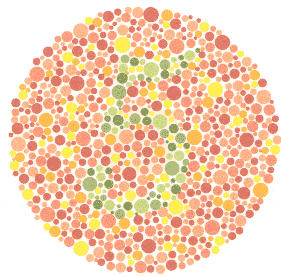
Ishihara color blindness test, from www.colour-blindness.com. If you can’t see the number 5, you might be colorblind. - Duchenne’s muscular dystrophy involves a malfunction in a protein called dystrophin that causes muscle cells to deteriorate. Symptoms can be observed in children as young as 2 or 3. Because muscles are involved in processes like breathing, the disease causes a significantly shorter lifespan, with many people with the condition dying in their 20s (or earlier). While girls can inherit the disease, it’s exceedingly rare (because a girl would have to inherit an allele from an affected father, and most men with the condition don’t live long enough to reproduce). You can learn more about Duchenne Muscular Dystrophy here.

Sex linkage also occurs in animals, most notably fruit flies, one of biology’s most studied organisms. In fruit flies, a recessive allele that causes white eyes is located on the X chromosome. The dominant allele codes for the normal phenotype, red eyes. While white eyes can be found in either sex, they’re much more commonly seen in males.
To solve genetics problems involving sex linkage, you use the same six steps that you’ve used in previous tutorials. Click here for a review.
[qwiz qrecord_id=”sciencemusicvideosMeister1961-Sex-Linkage Punnett Square (v2.0)”]
[h]Sex Linkage: Interactive Punnett Square
[q]A woman who is a carrier for hemophilia (she has the allele but not the trait) has children with a normal (non-hemophiliac) man. What will be the genotypes and phenotypes of their offspring?
Genotypes of the parents
Mother: ___ ___
Father: ___ ___
| Father | |||
| ___ | ___ | ||
| Mother | ___ | ___ ___ | ___ ___ |
| ___ | ___ ___ | ___ ___ | |
Genotype ratio:
_____XHY: ____XhY: _____XHXH: ___XHXh:_____XhXh
Phenotype ratio:
_____ Hemophiliac man
_____ Normal blood-clotting man:
_____ Homozygous normal woman
_____ Carrier (heterozygous) woman
_____ Hemophiliac woman
[l]XH
[fx] No. Please try again.
[f*] Excellent!
[l]Y
[fx] No, that’s not correct. Please try again.
[f*] Good!
[l]Xh
[fx] No. Please try again.
[f*] Great!
[l]0%
[fx] No. Please try again.
[f*] Good!
[l]25%
[fx] No. Please try again.
[f*] Excellent!
[l]50%
[fx] No, that’s not correct. Please try again.
[f*] Correct!
[l]75%
[fx] No. Please try again.
[f*] Good!
[l]100%
[fx] No. Please try again.
[f*] Correct!
[x]
[restart]
[/qwiz]
5. Sex-linkage problems in the ZZ/ZW system in Birds
As we saw earlier in this unit, birds have a sex determination in which males are ZZ and females are ZW.
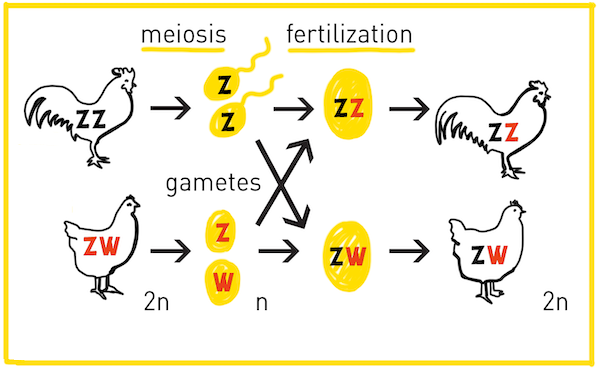
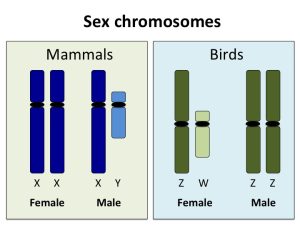 In the same way that the X chromosome is significantly larger than the Y, the Z chromosome is larger than the W. And in the same way that there are alleles that are carried on the X chromosome that aren’t carried on the Y, there are alleles on the Z chromosome that aren’t on the W chromosome. These alleles on the Z chromosome are (like alleles on the X chromosome) called sex-linked alleles.
In the same way that the X chromosome is significantly larger than the Y, the Z chromosome is larger than the W. And in the same way that there are alleles that are carried on the X chromosome that aren’t carried on the Y, there are alleles on the Z chromosome that aren’t on the W chromosome. These alleles on the Z chromosome are (like alleles on the X chromosome) called sex-linked alleles.
Knowing that, try to solve a few problems that involve sex-linked alleles in birds. All of these problems are based on the same scenario.
Domestic chickens have been bred for many years to increase the number of eggs laid by the females. Chick breeders need to be able to identify female chicks on the day after hatching, as only the females need to be kept for laying eggs.
Some genes for feather color and pattern in chickens are carried on the Z chromosome but not on the W chromosome. One such example is the gene for striped feathers (barring).
The phenotypes associated with the two alleles of the barring gene are shown in the table below
| Allele | Adult Phenotype | Day old chick phenotype |
| B | Barred (black feathers striped with white bars) | Black body with a white spot on the head |
| b | Non-barred (black feathers) | Black body and head |
[qwiz qrecord_id=”sciencemusicvideosMeister1961-Sex-Linkage in Birds (v2.0)”]
[h]Sex-linkage problems in birds.
[i]
[q]An individual with genotype ZBZb will, as an adult, have which phenotype?
[c]IEJhcnJl ZCBtYWxl[Qq]
[f]IEV4Y2VsbGVudC4gQW4gaW5kaXZpZHVhbCB3aXRoIGdlbm90eXBlIA==Wg==Qg==Wg==Yg==[Qq] will be a barred male (ZZ = male, and B is the allele for barring)
[c]IEJhcnJlZCBmZW1hbGU=[Qq]
[f]IE5vLiBKdXN0IGxvb2sgYXQgdGhlIHByb2JsZW0gYW5kIGFzayB5b3Vyc2VsZiB0d28gcXVlc3Rpb25zLiBGaXJzdGx5LCB3aGF0IGNocm9tb3NvbWFsIGNvbWJpbmF0aW9ucyBhcmUgYXNzb2NpYXRlZCB3aXRoIHdoaWNoIHNleD8gSW4gb3RoZXIgd29yZHMsIFhZIG1ha2VzIGFuIGluZGl2aWR1YWwgbWFtbWFsIG1hbGUsIGFuZCBYWCBtYWtlcyBmZW1hbGVzLiBXaGF0JiM4MjE3O3MgdGhlIHBhcmFsbGVsIGluIGJpcmRzPyBTZWNvbmRseSwgaXMgdGhlIGJhcnJpbmcgYWxsZWxlIGRvbWluYW50IG9yIHJlY2Vzc2l2ZT8gUHV0IHRob3NlIHRvZ2V0aGVyLCBob2xkIGl0IGluIG1lbW9yeSwgYW5kIHlvdSYjODIxNztsbCBnZXQgdGhpcyBxdWVzdGlvbiByaWdodCBuZXh0IHRpbWUu[Qq]
[c]IE5vbi1iYXJyZWQgZmVtYWxl[Qq]
[f]IE5vLiBKdXN0IGxvb2sgYXQgdGhlIHByb2JsZW0gYW5kIGFzayB5b3Vyc2VsZiB0d28gcXVlc3Rpb25zLiBGaXJzdGx5LCB3aGF0IGNocm9tb3NvbWFsIGNvbWJpbmF0aW9ucyBhcmUgYXNzb2NpYXRlZCB3aXRoIHdoaWNoIHNleD8gSW4gb3RoZXIgd29yZHMsIFhZIG1ha2VzIGFuIGluZGl2aWR1YWwgbWFtbWFsIG1hbGUsIGFuZCBYWCBtYWtlcyBmZW1hbGVzLiBXaGF0JiM4MjE3O3MgdGhlIHBhcmFsbGVsIGluIGJpcmRzPyBTZWNvbmRseSwgaXMgdGhlIGJhcnJpbmcgYWxsZWxlIGRvbWluYW50IG9yIHJlY2Vzc2l2ZT8gUHV0IHRob3NlIHRvZ2V0aGVyLCBob2xkIGl0IGluIG1lbW9yeSwgYW5kIHlvdSYjODIxNztsbCBnZXQgdGhpcyBxdWVzdGlvbiByaWdodCBuZXh0IHRpbWUu[Qq]
[c]IE5vbi1iYXJyZWQgbWFsZQ==[Qq]
[f]IE5vLiBKdXN0IGxvb2sgYXQgdGhlIHByb2JsZW0gYW5kIGFzayB5b3Vyc2VsZiB0d28gcXVlc3Rpb25zLiBGaXJzdGx5LCB3aGF0IGNocm9tb3NvbWFsIGNvbWJpbmF0aW9ucyBhcmUgYXNzb2NpYXRlZCB3aXRoIHdoaWNoIHNleD8gSW4gb3RoZXIgd29yZHMsIFhZIG1ha2VzIGFuIGluZGl2aWR1YWwgbWFtbWFsIG1hbGUsIGFuZCBYWCBtYWtlcyBmZW1hbGVzLiBXaGF0JiM4MjE3O3MgdGhlIHBhcmFsbGVsIGluIGJpcmRzPyBTZWNvbmRseSwgaXMgdGhlIGJhcnJpbmcgYWxsZWxlIGRvbWluYW50IG9yIHJlY2Vzc2l2ZT8gUHV0IHRob3NlIHRvZ2V0aGVyLCBob2xkIGl0IGluIG1lbW9yeSwgYW5kIHlvdSYjODIxNztsbCBnZXQgdGhpcyBxdWVzdGlvbiByaWdodCBuZXh0IHRpbWUu[Qq]
[q json=”true” xx=”1″ multiple_choice=”true” unit=”5.Heredity” dataset_id=”2019 AP Bio Dataset|22bbf7a863f45a” question_number=”29″ topic=”5.4.Non-Mendelian_Genetics”] An individual with genotype ZBW will, as an adult, have which phenotype?
[c]IEJhcnJlZCBtYWxl[Qq]
[f]IE5vLiBKdXN0IGxvb2sgYXQgdGhlIHByb2JsZW0gYW5kIGFzayB5b3Vyc2VsZiB0d28gcXVlc3Rpb25zLiBGaXJzdCwgd2hhdCBjaHJvbW9zb21hbCBjb21iaW5hdGlvbnMgYXJlIGFzc29jaWF0ZWQgd2l0aCB3aGljaCBzZXg/IEluIG90aGVyIHdvcmRzLCBYWSBtYWtlcyBhbiBpbmRpdmlkdWFsIG1hbW1hbCBtYWxlLCBhbmQgWFggbWFrZXMgZmVtYWxlcy4gV2hhdCYjODIxNztzIHRoZSBwYXJhbGxlbCBpbiBiaXJkcz8gU2Vjb25kLCBpcyB0aGUgYmFycmluZyBhbGxlbGUgZG9taW5hbnQgb3IgcmVjZXNzaXZlPyBQdXQgdGhvc2UgdG9nZXRoZXIsIGhvbGQgaXQgaW4gbWVtb3J5LCBhbmQgeW91JiM4MjE3O2xsIGdldCB0aGlzIHF1ZXN0aW9uIHJpZ2h0IG5leHQgdGltZS4=[Qq]
[c]IEJhcnJlZC BmZW1hbGU=[Qq]
[f]IFRlcnJpZmljLiBZb3UmIzgyMTc7cmUgY2xlYXJseSB1bmRlcnN0YW5kaW5nIGhvdyBzZXggZGV0ZXJtaW5hdGlvbiBhbmQgc2V4LWxpbmtlZCBhbGxlbGVzIHdvcmsgaW4gYmlyZHMh[Qq]
[c]IE5vbi1iYXJyZWQgZmVtYWxl[Qq]
[f]IE5vLiBKdXN0IGxvb2sgYXQgdGhlIHByb2JsZW0gYW5kIGFzayB5b3Vyc2VsZiB0d28gcXVlc3Rpb25zLiBGaXJzdCwgd2hhdCBjaHJvbW9zb21hbCBjb21iaW5hdGlvbnMgYXJlIGFzc29jaWF0ZWQgd2l0aCB3aGljaCBzZXg/IEluIG90aGVyIHdvcmRzLCBYWSBtYWtlcyBhbiBpbmRpdmlkdWFsIG1hbW1hbCBtYWxlLCBhbmQgWFggbWFrZXMgZmVtYWxlcy4gV2hhdCYjODIxNztzIHRoZSBwYXJhbGxlbCBpbiBiaXJkcz8gU2Vjb25kLCBpcyB0aGUgYmFycmluZyBhbGxlbGUgZG9taW5hbnQgb3IgcmVjZXNzaXZlPyBQdXQgdGhvc2UgdG9nZXRoZXIsIGhvbGQgaXQgaW4gbWVtb3J5LCBhbmQgeW91JiM4MjE3O2xsIGdldCB0aGlzIHF1ZXN0aW9uIHJpZ2h0IG5leHQgdGltZS4=[Qq]
[c]IE5vbi1iYXJyZWQgbWFsZQ==[Qq]
[f]IE5vLiBKdXN0IGxvb2sgYXQgdGhlIHByb2JsZW0gYW5kIGFzayB5b3Vyc2VsZiB0d28gcXVlc3Rpb25zLiBGaXJzdGx5LCB3aGF0IGNocm9tb3NvbWFsIGNvbWJpbmF0aW9ucyBhcmUgYXNzb2NpYXRlZCB3aXRoIHdoaWNoIHNleD8gSW4gb3RoZXIgd29yZHMsIFhZIG1ha2VzIGFuIGluZGl2aWR1YWwgbWFtbWFsIG1hbGUsIGFuZCBYWCBtYWtlcyBmZW1hbGVzLiBXaGF0JiM4MjE3O3MgdGhlIHBhcmFsbGVsIGluIGJpcmRzPyBTZWNvbmRseSwgaXMgdGhlIGJhcnJpbmcgYWxsZWxlIGRvbWluYW50IG9yIHJlY2Vzc2l2ZT8gUHV0IHRob3NlIHRvZ2V0aGVyLCBob2xkIGl0IGluIG1lbW9yeSwgYW5kIHlvdSYjODIxNztsbCBnZXQgdGhpcyBxdWVzdGlvbiByaWdodCBuZXh0IHRpbWUu[Qq]
[q json=”true” xx=”1″ multiple_choice=”true” unit=”5.Heredity” dataset_id=”2019 AP Bio Dataset|22b874ee762c5a” question_number=”30″ topic=”5.4.Non-Mendelian_Genetics”]In a cross between a barred female and a non-barred male, what percentage of the offspring will be non-barred females?
[c]IDAl[Qq]
[f]IE5vLiBZb3UgaGF2ZSB0byB0cmVhdCB0aGlzIGxpa2UgYW55IGdlbmV0aWNzIHByb2JsZW0gdGhhdCBpbnZvbHZlcyBzZXggbGlua2FnZS4gSGVyZSBhcmUgdGhlIGdlbm90eXBlczogdGhlIGJhcnJlZCBmZW1hbGUgaXMgWg==Qg==[Qq]W. The non-barred male is ZbZb. Get a pencil, set up a Punnett square like the one below, and solve the problem (determining the proportion of each phenotype).
| ZB | W | |
| Zb | ||
| Zb |
Hold on to the answer until the next time you see the question.
[c]IDI1JQ==[Qq]
[f]IE5vLiBZb3UgaGF2ZSB0byB0cmVhdCB0aGlzIGxpa2UgYW55IGdlbmV0aWNzIHByb2JsZW0gdGhhdCBpbnZvbHZlcyBzZXggbGlua2FnZS4gSGVyZSBhcmUgdGhlIGdlbm90eXBlczogdGhlIGJhcnJlZCBmZW1hbGUgaXMgWg==Qg==[Qq]W. The non-barred male is ZbZb. Get a pencil, set up a Punnett square like the one below, and solve the problem (determining the proportion of each phenotype).
| ZB | W | |
| Zb | ||
| Zb |
Hold on to the answer until the next time you see the question.
[c]IDUw JQ==[Qq]
[f]IFlvdSYjODIxNztyZSBleGhpYml0aW5nIG1hcnZlbG91cyBtYXN0ZXJ5IG9mIChwb3N0KSBNZW5kZWxpYW4gZ2VuZXRpY3MhIDUwJSBvZiB0aGUgb2Zmc3ByaW5nIGFyZSBub24tYmFycmVkIGZlbWFsZXMuIElmIHlvdSYjODIxNztyZSBsaWtlIG1lLCB5b3Ugc2V0IHVwIHRoaXMgY3Jvc3MuIEFsbCB0aGUgZmVtYWxlcyBhcmUgbm9uLWJhcnJlZCAoWg==Yg==[Qq]W), and that’s 50% of the offspring.
| ZB | W | |
| Zb | ZBZb | ZbW |
| Zb | ZBZb | ZbW |
[c]IDc1JQ==[Qq]
[f]IE5vLiBZb3UgaGF2ZSB0byB0cmVhdCB0aGlzIGxpa2UgYW55IGdlbmV0aWNzIHByb2JsZW0gdGhhdCBpbnZvbHZlcyBzZXggbGlua2FnZS4gSGVyZSBhcmUgdGhlIGdlbm90eXBlczogdGhlIGJhcnJlZCBmZW1hbGUgaXMgWg==Qg==[Qq]W. The non-barred male is ZbZb. Get a pencil, set up a Punnett square like the one below, and solve the problem (determining the proportion of each phenotype).
| ZB | W | |
| Zb | ||
| Zb |
Hold on to the answer until the next time you see the question.
[c]IDEwMCU=[Qq]
[f]IE5vLiBZb3UgaGF2ZSB0byB0cmVhdCB0aGlzIGxpa2UgYW55IGdlbmV0aWNzIHByb2JsZW0gdGhhdCBpbnZvbHZlcyBzZXggbGlua2FnZS4gSGVyZSBhcmUgdGhlIGdlbm90eXBlczogdGhlIGJhcnJlZCBmZW1hbGUgaXMgWg==Qg==[Qq]W. The non-barred male is ZbZb. Get a pencil, set up a Punnett square like the one below, and solve the problem (determining the proportion of each phenotype).
| ZB | W | |
| Zb | ||
| Zb |
Hold on to the answer until the next time you see the question.
[x][restart]
[/qwiz]
6. A few more human genetic conditions to know about
On the AP Bio exam, you probably won’t be asked to demonstrate knowledge of any particular genetic disease. But as a biologically literate person, you should know about the following conditions.
6a. Sickle cell anemia
We covered this condition in the first tutorial on this topic, and also back in Unit 1 when we were learning about protein structure.
6b: Cystic fibrosis
Also covered in the first tutorial on this topic.
6c. Hemophilia and Red-Green Colorblindness
See above. We’ll discuss hemophilia again in the context of genetic engineering and gene therapy.
6d. Huntington’s disease

Huntington’s disease is a neurological disorder caused by an autosomal dominant allele. A homozygote will pass the condition on to 100% of his or her offspring; a heterozygote will pass it on to half of his or her offspring. The legendary folk singer Woody Guthrie (author of “This Land is Your Land”) died of the disease at age 55 and passed it on to two of his daughters.
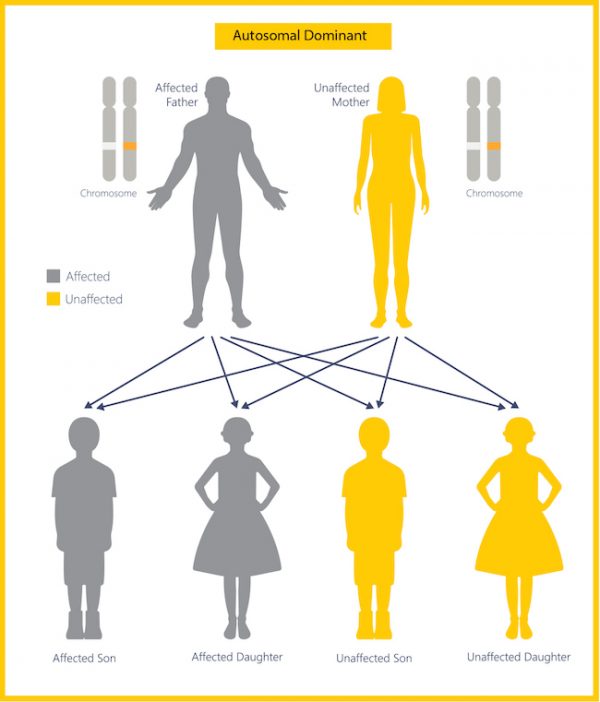
The disease strikes individuals in middle age and causes damage to tissue in the brain that controls movement, leading to symptoms such as personality changes, unsteady gait, and involuntary movements, and slurred speech. Most victims die from complications relating to the disease.
Because of the late onset of symptoms, most people with Huntington’s have, throughout history, reproduced before they knew they had the disease.
The gene for Huntington’s disease is on chromosome 4, and it involves repeats of the nucleotide bases CAG (cytosine-adenine-guanine) triplet, which codes for the amino acid glutamine. Excess glutamines in the resulting protein cause neurological degeneration. The age of onset is inversely correlated with the number of repeats (more repeats lead to earlier onset). Homozygotes for the Huntington’s allele have both earlier onset and more severe symptoms.
Recently, the gene for Huntington’s has been identified, allowing people with a family history of Huntington’s to get genetically tested to determine whether or not they’ve inherited the allele.
6e. Achondroplasia
Achodroplasia is an autosomal dominant condition that results in short arms and legs, but a torso of normal length. Homozygotes frequently die before birth or during infancy due to breathing difficulties. It’s the most common cause of dwarfism. In addition to being inherited from a heterozygous parent, achondroplasia can also emerge as a mutation in a parent’s gamete or germline cells. As a result, many people with achondroplasia have parents who are of normal height.
You can learn more on Wikipedia, or on this page from the National Human Genome Research Institute.
6f. Tay Sachs
In Tay-Sachs disease, a genetic mutation in an enzyme called beta-hexosaminidase A results in the build-up of a molecule called GM2 ganglioside in the brain. GM2 ganglioside buildup is toxic and ultimately fatal. Victims usually die before the age of five, and there is no treatment.
The disease is autosomal and recessive. In certain populations (Jews of Eastern European descent and Louisiana Cajuns) the frequency of the Tay-Sachs allele is significantly higher than in the surrounding populations. There has been speculation that there might be some heterozygote advantage at work (as with the sickle cell allele), possibly in relation to tuberculosis, but this advantage has not been substantiated.
You can learn more about Tay-Sachs disease on this page from Mount Sinai Hospital
7. What’s next?
Please continue to Topic 5.3-5.5, part 4: Dihybrid Crosses, the next tutorial in AP Bio Unit 5.
